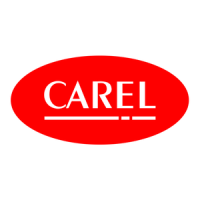Code +030220811- rel. 1.0 – 26.04.2007
18
8. Control devices: advanced parameter settings
The control of the electronic valve can be divided into two categories: superheat control with reference to the
corresponding set point, and control of unit safety with protectors that are activated only if the pressure or
temperature reach dangerous values that can be set by the user.
8.1 Superheat control parameters
The superheat control function involves calculating the position of the valve based on the reading of the superheat
and the corresponding set point.
As control is PID (Proportional, Integral, Derivative), hereinafter the control algorithm will simply be called “PID”.
The PID is the sum of three distinct actions:
Proportional action (P), defined by parameter K = proportional gain.
The proportional action opens or closes the valve by K steps whenever the superheat increases or decreases by 1 °C.
Consequently, the higher the value of K, the faster the reaction of the valve to variations in the superheat.
The proportional action is fundamental, as it affects the speed of response of the valve in general, however it only
considers the variation in the superheat, and not the corresponding set point.
Therefore if the superheat does not vary significantly, the valve will essentially remain steady and the superheat set
point may not be reached.
Integral action (I), defined by parameter Ti = integration time (sec)
The integral action is related to time and makes the valve move in proportion to how far the superheat temperature
is away from the set point. The higher the difference, the more intense the integral action; the lower the integration
time (Ti), the more intense be the integral action.
The integral action is required to ensure that the superheat reaches the set point. Without this, in fact, the
proportional action alone may stabilise the superheat at a value other than the set point.
Derivative action (D), defined by parameter Td = derivative time (sec)
The derivative action is related to the speed with which the superheat varies, that is, the instant-by-instant gradient
of superheat variation. This tends to contrast sudden variations in the superheat, bringing forward the corrective
action; the effect is more intense the higher the time Td.
Valve opening at start-up, defines the percentage of opening that the valve moves to immediately before starting
superheat control and should be set so as to be near the normal working position during control.
As an initial approximation, it can be determined by calculating the ratio between the cooling capacity of the
evaporator and the cooling capacity of the valve. A 10 kW valve installed on a 5 kW evaporator will presumably
operate at 50 % opening.
The following parameters are involved:
• Valve opening at start-up (EVAP/EEV capacity ratio)
• Superheat set point
• PID: proportional gain
• PID: integration time
• PID: derivative time
control

